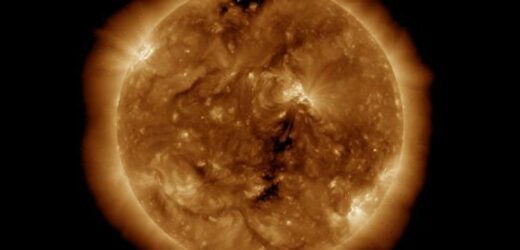Solar storm: NASA captures the moment a sunspot 'explodes'
We use your sign-up to provide content in ways you’ve consented to and to improve our understanding of you. This may include adverts from us and 3rd parties based on our understanding. You can unsubscribe at any time. More info
Space weather forecasters have issued a solar storm alert for Monday and Tuesday following a burst of solar activity on the Sun. The star has released so-called coronal mass ejection or CME on Saturday, which is forecast to slam into the Earth’s magnetic field by about 5pm BST (12pm EST). The impact is forecast to trigger a “moderate” or G2 solar storm that has the potential to disrupt satellite technology.
According to the US Space Weather Prediction Center (SWPC), the storm could induce power grid fluctuations, meddle with satellite operations and even interfere with radio signals.
An amber alert for auroras has also been issued in the UK, as forecasters predict the mesmerising Northern Lights (Aurora Borealis) could be visible from parts of the country, weather permitting.
News of an imminent solar storm has now sparked fears on social media, however, experts have assured the impacts are going to be marginal.
Twitter user Simon Fox said: “OK, I don’t want to spook anyone in this time of artificially stoked #panic… but there is a possibility that a #SolarStorm will hit the UK today around 5pm.


“Be prepared, as my Scout leader used to say. (I was never a Scout).”
Earlier this summer scientists warned of the dangers and potential economic fallout associated with extreme space weather.
Forecasters rank solar storms based on the strength on a scale of G1 (Minor) to G5 (Extreme).
One of the most powerful solar storms to ever hit the planet was the 185 Carrington Event, which is reported to have set telegraph wires across Europe and North America sparkling.
A similar-sized storm was narrowly avoided in 2012 after a powerful CME swung by the planet.
Earth’s ‘magnetic song’ captured during solar storm
CMEs are large expulsions of plasma and magnetic field from the Sun that interact with Earth’s magnetic field, inducing a number of space weather phenomena.
Following the close-brush with the CME nine years ago, it was estimated the resulting storm could have incurred a bill of up to £1.45trillion ($2trillion).
Solar physicist Tamitha Skov has now said today’s expected storm could see some disruptions to satellite technology, though she does not expect any issues with power grids.
Instead, she argued the storm is most likely going to be a “minor inconvenience” to radio and GPS operators.
Dr Skov tweeted: “The impact is global, but higher latitudes will be impacted more than lower latitudes because of the nature of these storms and how they interact with the Earth’s magnetic field.”


In another tweet, she said: “No need for drastic measures. Too much scaremongering in #SpaceWeather these days!
“This #solarstorm will be a minor inconvenience with amateur #radio and #GPS users being the most adversely affected.
“National power utilities have procedures in place for a G2-level storm like this!”
Dr David Smith of the Institution of Engineering and Technology (IET) also tweeted: “You may be seeing some excitable tweets about a solar storm headed our way.
“1) Yes it is.
“2) Not hit us yet as of 4.25pm GMT
“3) It’s not predicted to be a whopper. G1 or 2 on a scale that goes to 5 (where 4 and 5 are the severe ones)
“If you live oop north you may see #aurora”
According to the website SpaceWeather.com, there was only a 35 percent chance of geomagnetic or solar storms today.
The website’s experts said: “If such a storm occurs during nighttime hours, auroras could be visible in northern-tier US states from New England to Washington.”
Cybersecurity expert Chris Vickery also assured the storm is not going to affect critical pieces of machinery like pacemakers.
He tweeted on Sunday: “I just realised this kind of thing is probably not reassuring for people with pacemakers.
“Tomorrow isn’t going to cause them problems but understanding that even larger magnetic storms can happen (and have happened before) might cause some amount of worry there.”
Source: Read Full Article


